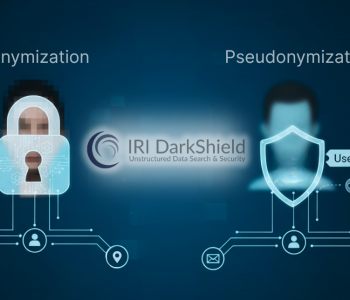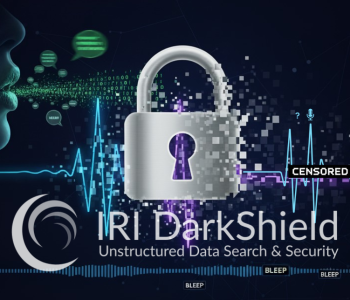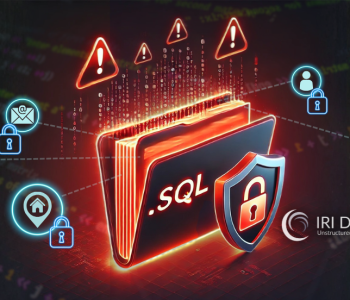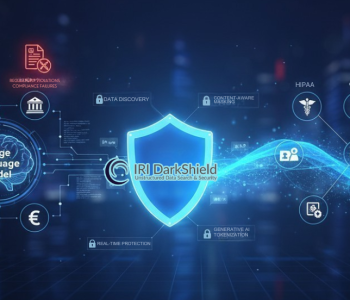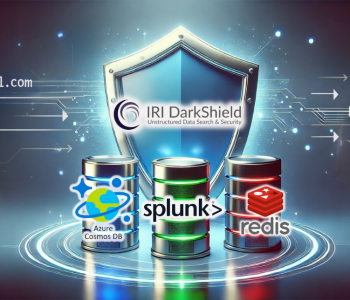
Masking PII in ETL Jobs
Governance-driven data architects are increasingly adopting ETL masking workflows to ensure data privacy and compliance without disrupting analytics, operations, or development. As data moves from one environment to another—especially during extraction, transformation, and loading (ETL)—it’s critical to protect sensitive data from unauthorized access.
This is where IRI FieldShield, a top-tier data masking solution in the IRI Data Protector Suite, plays a vital role. Designed to mask sensitive information in RDB, flat-file, Excel, and ASN.1 sources, FieldShield can combine seamlessly with either IRI Voracity or third-party ETL tools to enforce security throughout the entire data pipeline.
In this article, we’ll explore how integrating FieldShield into ETL pipelines leads to effective ETL masking workflows, reduces data breach risk, complies with data privacy laws, and provisions safe, intelligent test data. We’ll also cover best practices, real-world applications, and key benefits of automating masking with ETL.
Why ETL Masking Matters
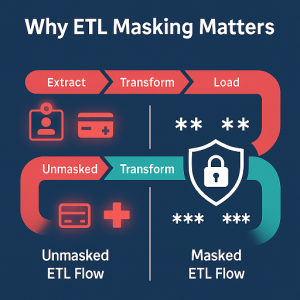
ETL (Extract, Transform, Load) processes are foundational to data warehousing, migration, analytics, and reporting. During these workflows, sensitive data, such as PII, financial records, or health data, may move between multiple systems—often across on-premises and cloud environments.
Without integrated masking, this movement becomes a major vulnerability. Data in transit or during transformation can be exposed. If not protected, the risk of data leakage, unauthorized access, or non-compliance with regulations like GDPR, HIPAA, or DPDP increases significantly.
By embedding masking directly into your ETL flow, you ensure that sensitive data is consistently protected—no matter where it travels.
IRI FieldShield: A Seamless Fit for ETL Masking Workflows
IRI FieldShield is a robust data masking engine capable of discovering and masking sensitive information in structured databases, flat files, Excel sheets, and ASN.1 CDRs. When integrated into ETL processes, it helps automate redaction, scrambling, encryption, hashing, or pseudonymization of data in real time.
Here’s how FieldShield enhances ETL masking workflows:
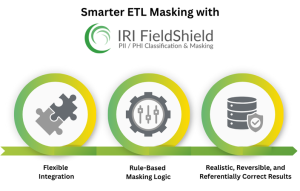
1. Flexible Integration
FieldShield masking functions can be used directly in IRI Voracity ETL (CoSort SortCL) transformation job scripts, or called externally via its CLI or API from any third-party ETL platform, like DataStage, Talend, Informatica, Pentaho, Boomi, et al.
This enables data masking to become a step in your ETL process—right after extraction or during transformation—before loading the sanitized data into target environments.
2. Rule-Based Masking Logic
Using customizable masking rules, FieldShield ensures different data elements are treated based on their sensitivity and context. You can create masking profiles to specify how names, emails, account numbers, or medical codes are handled in different workflows.
3. Realistic, Reversible, and Referentially Correct Results
FieldShield supports deterministic format-preserving encryption (FPE) and reversible pseudonymization, allowing masked data to remain usable for testing, analytics, or AI/ML training, while ensuring uniqueness, privacy, and consistency across all sources and targets.
ETL Integration in Action: Real-World Use Cases
a. Healthcare Data Pipelines

Hospitals and healthcare providers use ETL to centralize records for analytics and operational planning. With FieldShield integrated into the pipeline, PHI can be masked immediately after extraction—ensuring compliance with HIPAA before any data hits the data lake or warehouse.
b. Financial Reporting

Banks often aggregate data from multiple sources for reporting, modeling, or fraud detection. FieldShield masks PII, account numbers, and credit details during ETL flows, so internal teams work with sanitized data—without losing analytical value.
c. Data Migration and Cloud Onboarding
As organizations move legacy systems to the cloud, data masking becomes crucial. With FieldShield embedded in migration ETL jobs, sensitive data is masked before landing in the new cloud platform, ensuring secure onboarding.
Benefits of Integrating FieldShield Data Masking Functions in ETL Workflows
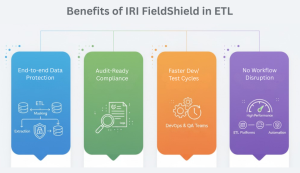
1. End-to-End Data Protection
By incorporating masking into ETL, sensitive data is protected from extraction through to final loading—eliminating blind spots.
2. Audit-Ready Compliance
FieldShield logs masking activities, making it easier to prove compliance during data audits or regulatory inspections.
3. Faster Dev/Test Cycles
DevOps and QA teams can work with realistic yet non-sensitive data, thanks to masked datasets generated during ETL runs.
4. No Workflow Disruption
FieldShield’s lightweight integration ensures minimal impact on ETL performance, especially when deployed alongside workflow automation platforms.
Role of Data Integration Tools and Automation
Modern enterprises use diverse data integration tools to manage large-scale data flows—tools like Apache Nifi, Microsoft SSIS, Informatica, and the IRI Voracity platform itself. These tools support scheduled, conditional, and event-driven ETL jobs.
FieldShield can be integrated directly into these workflows using scripts, APIs, or built-in connectors. Whether you’re processing daily data loads or running hourly updates, masking can happen automatically—aligned with your workflow automation strategy.
This level of integration ensures:
- Consistently masked data across business units
- Simplified maintenance of data privacy policies
- Reduced risk of human error in manual masking steps
When combined with orchestration tools like Airflow, Control-M, or Kubernetes-based pipelines, FieldShield enables enterprises to scale privacy enforcement across hybrid environments.
FAQs: Integrating FieldShield with ETL
Q1. Can FieldShield be used with cloud-based ETL tools like AWS Glue or Azure Data Factory?
Yes. FieldShield’s API and command-line options allow it to integrate with both cloud and on-premise ETL tools, including AWS Glue, Azure Data Factory, and GCP Dataflow.
Q2. How does masking affect ETL performance?
FieldShield is optimized for speed and parallel processing. While masking adds a step to ETL, its efficient design ensures minimal overhead—especially when applied selectively to sensitive fields. Note that with FieldShield functions in Voracity ETL, there is no extra step.
Q3. Can FieldShield maintain referential integrity in masked datasets?
Yes. It can preserve data relationships using consistently applied deterministic data masking rules like pseudonymization or encryption (tokenization), ensuring that joins and lookups still work correctly in masked datasets.
Q4. Do I need coding skills to integrate FieldShield into ETL workflows?
Not necessarily. While scripting or API calls may be helpful for advanced customizations, FieldShield provides GUI wizards, outlines, and mapping diagrams to build the job scripts visually.
Final Thoughts
Incorporating data masking into your ETL pipeline is no longer optional—it’s essential. Whether you’re handling sensitive customer records, financial data, or healthcare information, ETL masking workflows help secure your data at every stage of its journey.
By integrating IRI FieldShield into your ETL processes, you gain more than just privacy protection—you build compliance, trust, and operational efficiency. With support for data integration tools, flexible masking logic, and workflow automation, FieldShield empowers you to manage privacy at scale without compromising data utility.
If you haven’t already, consider embedding masking into your ETL workflows as soon as possible — because data privacy by design begins with the pipeline.



